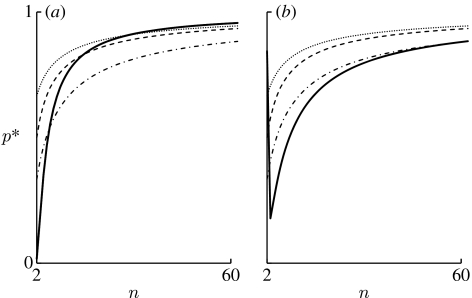Figure 3.
Comparison of the frequency of TFTn−1 at the unstable polymorphic equilibrium in the deterministic model (p*) with the conditions ρALLD>1/N, and when N is large. The solid line represents the frequency of TFTn−1 at the unstable polymorphic equilibrium, p*, in the deterministic model. The other three lines represent the thresholds of p* above which ρALLD>1/N (dotted line), (dashed line) or (dot-dashed line). (a) The situation when b/c and m are constant (b/c=1.5 and m=30). The solid line is below the dot-dashed line, which means that p* is smaller than the threshold above which , if and only if n≤5. Hence, is satisfied if and only if n≤5. Similarly, holds if and only if n≤14, while ρALLD<1/N holds if and only if n≤29. In this case, the evolution of cooperation becomes more difficult with increasing group size. (b) The situation when b/(nc) and m are constant (b/(nc)=0.51 and m=30). The condition is satisfied if and only if 3≤n≤57, while and are always satisfied unless n=2. In this case, the situation under which TFTn−1 more readily replaces ALLD than vice versa and the situation under which cooperation is maintained are both more likely to be realized when the group size is larger.

